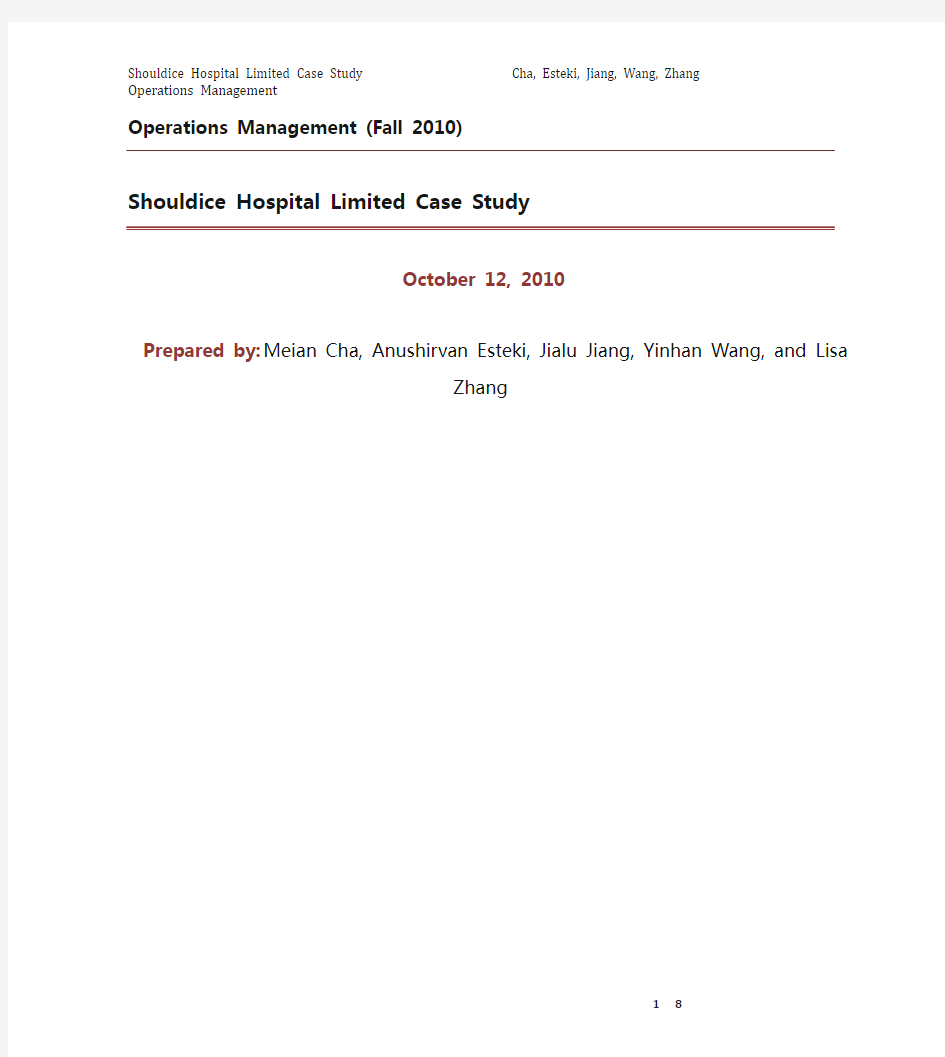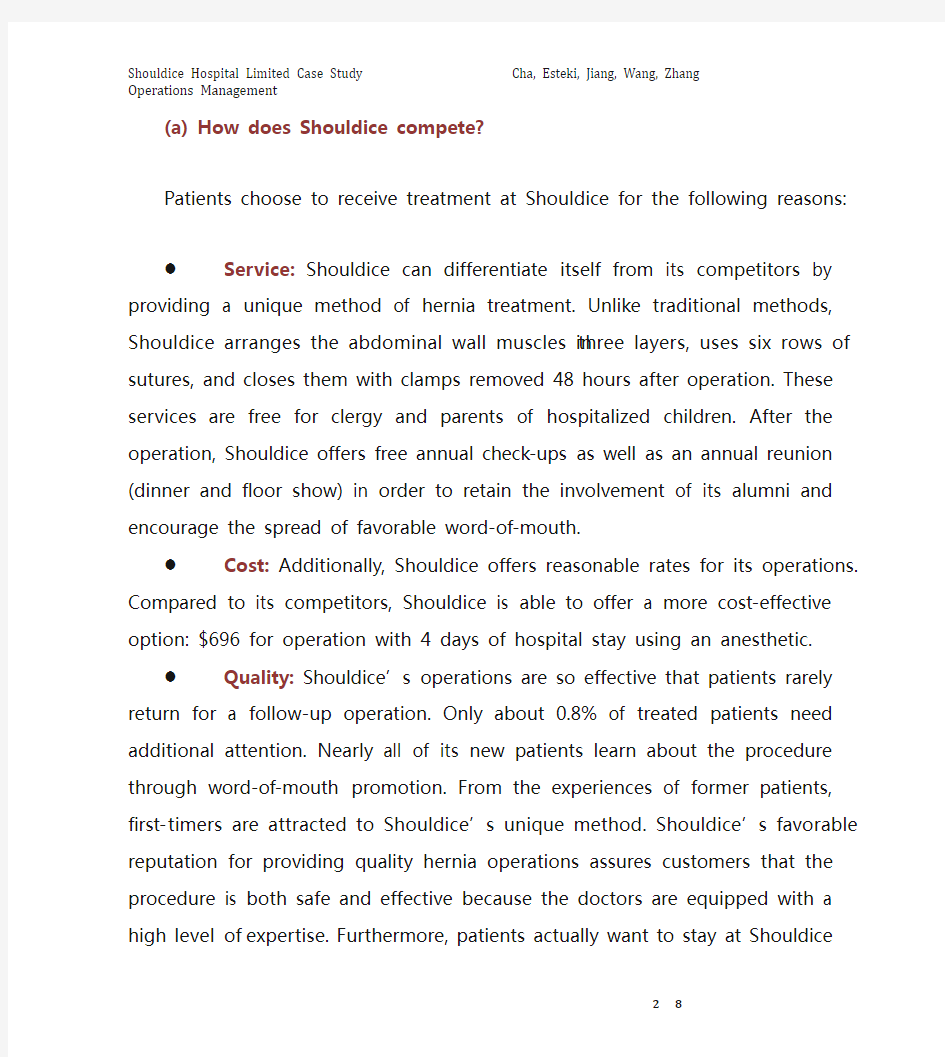

OPERATIONS MANAGEMENT (FALL 2010)
October 12, 2010
Prepared by:Meian Cha, Anushirvan Esteki, Jialu Jiang, Yinhan Wang, and Lisa Zhang
(a) How does Shouldice compete?
Patients choose to receive treatment at Shouldice for the following reasons:
●Service:Shouldice can differentiate itself from its competitors by providing a
unique method of hernia treatment. Unlike traditional methods, Shouldice arranges the abdominal wall muscles in three layers, uses six rows of sutures, and closes them with clamps removed 48 hours after operation. These services are free for clergy and parents of hospitalized children. After the operation, Shouldice offers free annual check-ups as well as an annual reunion (dinner and floor show) in order to retain the involvement of its alumni and encourage the spread of favorable word-of-mouth.
●Cost: Additionally, Shouldice offers reasonable rates for its operations. Compared
to its competitors, Shouldice is able to offer a more cost-effective option: $696 for operation with 4 days of hospital stay using an anesthetic.
●Quality:Shouldice’s operations are so effective that patients rarely return for a
follow-up operation. Only about 0.8% of treated patients need additional attention.
Nearly all of its new patients learn about the procedure through word-of-mouth promotion. From the experiences of former patients, first-timers are attracted to Shouldice’s unique method. Shouldice’s favorable reputation for providing quality hernia operations assures customers that the procedure is both safe and effective because the doctors are equipped with a high level of expertise. Furthermore, patients actually want to stay at Shouldice after hearing about the experiences of former patients. They think of the operation as a “three-day holiday” and an
opportunity to forge friendships with other patients.
●Time (delivery):The procedure lasts only 45 minutes. Furthermore, the fast
recovery period involving physical activity and support from other patients and the staff allows patients to minimize their hospital stay.
●Proximity:How far or close the patients are to the facility determines whether or
not the patient will opt to be treated at Shouldice. Most of the patients live close to Shouldice, but approximately 12% are from the United States. Further, 2% are from provinces other than Ontario or European countries.
(b) Identify characteristics of Shouldice’s operations that contribute to its success.
Hardware (flow of physical goods):
●Sedation:The preoperative sedation consisting of analgesic, local anesthetic,
Demerol, and Novocain contribute to “immediate patient ambulation and rapid recovery.”
●Method:Unlike other methods, the Shouldice method requires separating the
abdominal muscle wall into three layers, six rows of sutures, and closing the wall with clamps that will be removed 48 hours later.
●Cost savings: Shouldice has the capability to lower costs in several ways. A lower
nurse-to-patient ratio and fewer housekeeping services (such as laundry) stem from the nature of the procedure. In addition, all food served is prepared in one kitchen and the cost per meal averages about $1.10. Finally, because of the central
supply area, Shouldice only needs to spend no more than $30,000 on furnishing an operating room.
●Facility layout: The design of the facility facilitates a nurturing environment for
the patients. The floors are carpeted to reduce a hospital feeling. Assigning two patients to the room, scheduling social activities, exercise and sun rooms, walking, and the absence of telephones and television sets all encourage positive social interactions among the patients and staff.
Software (flow of information):
●Doctor experience: Due to the rigorous selection and interview process, doctors
are chosen based upon experience and education. Surgeons at Shouldice have a high track record having performed more than 600 operations. Additionally, surgeons train under direct supervision of senior surgeon in order to adhere to the unvaried Shouldice technique. During the process, surgeons rotate every few days and have the opportunity to familiarize themselves with the patient before the actual operation. While most procedures prove successful, those patients who require another operation are seen by the same doctor. Overall, retention is high due to the specialized nature of the work, flexible work-life balance (they finish work by 4 pm and have limited on-call time), and high salary and bonus. The profit-sharing plan also encourages doctors to collaborate and perform exceptionally.
●Patient operation schedule:When patients arrive at Shouldice, they are treated
and operated on right away. The structured timetable shortens the total hospital stay to 5-6 days rather than 7-8 days, and provides detailed time allocations for pre-operation, operation, and recovery. Shouldice also uses control mechanisms that serve as selection tools for its patients, requiring a diagnosis through a questionnaire and examination procedure.
●Speed:The procedure performed on first-time repairs (primaries) requires
approximately 45 minutes. The postoperative regimen consists of recovery time of one week for light work, and four weeks of benefits and recuperation for strenuous work.
●Strong administration/company culture:Shouldice’s focus upon its
employees through the time and attention spent, the high pay scale offered, and the absence of organizational charts contribute to the low turnover rate and overall employee satisfaction. In addition, employees are trained to be knowledgeable of various job tasks enabling flexibility, especially in periods of high activity, as well as a “help each other” attitude.
(c) Develop a process flow diagram for Shouldice Hospital.
The three lines form one single process even if depicted separately. In the Examination, a patient is sent home if she did not follow the weight loss plan or does not have an hernia. In the Accounting Office and the Nurses’ Station, if problems are encountered, the patient is sent home.
Home
Room
Recovery Arrival Wait Examination
Wait Home Acctg Office Nurse Stat.Room
Home Home
Nurse Stat.
Acctg Office
Examination Examination
Examination
Examination
Examination Wake Up Wait Postop Room Room
Operation
Preparation Operation
Operation Operation
Operation
Table 1 shows the base case, Table 2 shows the figures after the resolution of the bottleneck and Table 3 shows the figures for the increased capacity. The manufacturing lead time is 4 days in any case and the number of patients in the facility at any time is 144 in the first case, 160 after the resolution of the bottleneck and 192 in the third case. The number of stations under Rooms indicates the number of beds available.
(d) Identify the bottleneck and determine the capacity for Shouldice.
Based on our process flow diagram, we found that Administrative Check and the Blood and Urine Check stages are the bottlenecks.
(e) What should Shouldice do to increase the capacity?
In question (d), we identified the bottlenecks to be the Administrative Check and Blood and Urine Check stages. To resolve the bottlenecks and increase the capacity, Shouldice should:
1)Increase one more nurse and one more accountant to increase the capacity from 36
patients per day to 54 patients for the Administrative Check and the Blood and Urine Checks.
2)If increased, the bottleneck would become the Operation Room with 40 operations
per day, which is an 11% increase in output.
3)Building another operation room would now increase the capacity of the operations
to 48 operations per day; this would result in an additional 20% increase. In addition to the construction of the operation room, we also need to increase the patient room capacity by 7 and the bed capacity by 14 at least.
4)If we extend operations to Saturdays, another 20% in capacity could be reached.
This is almost a 60% increase in capacity overall.